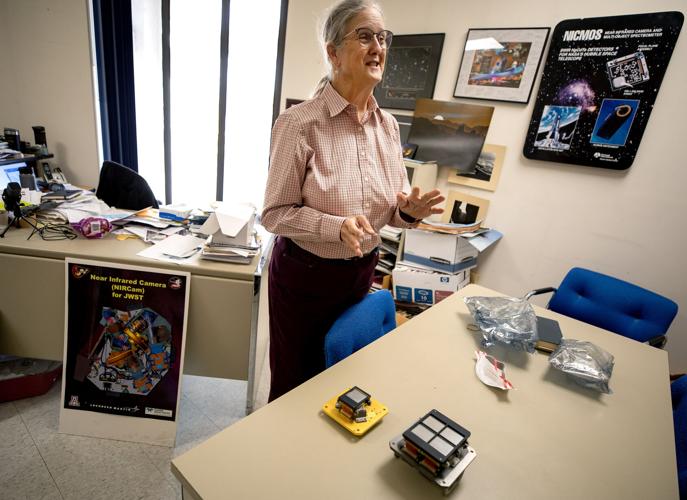NASA now knows what’s cooking on a “hot Saturn” 700 light-years from Earth, thanks to a camera designed at the University of Arizona and key contributions from local scientists.
The James Webb Space Telescope has been able to identify a full menu of atoms, molecules, and even signs of clouds and active chemistry in the atmosphere of WASP-39b, a Saturn-sized planet that orbits closer to its star than Mercury does to our sun.
The space agency announced the findings on Tuesday. The discoveries will be spelled out in five new scientific papers slated for release in the coming months.
Webb tracked WASP-39b as it passed in front of its star and used changes in the color of starlight filtering through the planet’s atmosphere to detect the presence of different chemicals.
The observations were made using Webb’s Near-Infrared Camera, or NIRCam, which was designed by a team led by Marcia Rieke, a Regents Professor at UA’s Steward Observatory. The infrared instrument can pick up chemical fingerprints that can’t be detected in visible light.
Previous observations of WASP-39b by other space telescopes showed the presence of a “mystery molecule” scientists could not identify. NIRCam revealed the molecule to be sulfur dioxide, which had never been detected in the atmosphere of an exoplanet before.
That’s exciting, said Megan Mansfield, a NASA Sagan Fellow at Steward Observatory, because sulfur dioxide is produced from chemical reactions triggered by intense light from a nearby star, much the way the protective ozone layer forms in Earth’s upper atmosphere.
“In order for this molecule to be detected as clearly as it was, we think there must have been some photochemistry going on in the atmosphere, which has never been observed in a planet outside of our solar system,” Mansfield said.
Everett Schlawin, an assistant research professor at Steward, provided technical input on the observations to figure out how the starlight filtered through the atmosphere of the planet.
Scientists relied on computer models designed by UA postdoctoral research fellow Sarah Moran to fully explain the photochemical data from WASP-39b. Improvements to such modeling could be used in the future to interpret potential signs of habitability on known exoplanets and worlds yet to be discovered.
Along with the sulfur dioxide, Moran said, researchers detected sodium, potassium, water, carbon dioxide and carbon monoxide in the distant planet’s atmosphere.
They also found evidence of clouds and complex meteorological patterns similar to those seen on planets in our own solar system, she said.
WASP-39b is not to be confused with WASP-96b, one of the first exoplanets to be imaged by the new space telescope after it was launched on Christmas Day 2021. Also a gas giant, WASP-96b can be found in the southern-sky constellation Phoenix, about 1,500 light-years from Earth.
The findings just announced by NASA highlight the dizzying pace of discovery for an advancing field that has gone from finding its first exoplanet in 1992 to pinpointing more than 5,200 distant worlds.
Astronomers have identified another 9,100 candidate planets for possible confirmation, with billions more waiting to be found in our galaxy alone.
Webb should be able help with that effort, teasing out more enticing details from faraway alien skies.
“Our collective effort verified that JWST works incredibly well to measure new molecules in atmospheres and find new mysteries, which is incredibly invigorating,” Mansfield said.
It hasn’t been taking photos for long, but it’s already showing its value.






